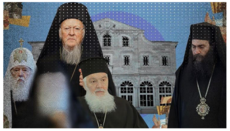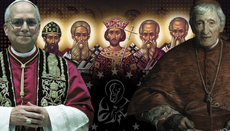Armenian Primate Says Armenian Church is “Not Monophysite”—But Is This True?

On May 30, 2025, Catholicos Aram I of Armenia stated during a presentation in the Old Greek Parliament that the Armenian Church is not Monophysite and holds to an Orthodox Christology.
We are not Monophysites. It’s not merely my claim—history confirms it. We are not Monophysites! ‘One nature’ is heresy. The dual, united nature is Orthodoxy. Our theology is rooted in our shared apostolic foundation. Our interpretation is Orthodox… We share a common Christology, though with different interpretations.
Yet, in his words, he unwittingly reveals the root of the error that led the Armenian Church to separate from the Holy Orthodox Church of Christ: while rejecting “one nature,” he goes on to affirm a “dual, united nature.”
The Monophysites (or Miaphysites, as they prefer to be called) reject the Council of Chalcedon specifically because, according to its definition, the two natures in Christ exist fully and distinctly—not mixed, not diminished, but united without confusion: 100% divine, 100% human. Each nature operates in the life of Christ according to its own properties. As St. John of Damascus writes:
The hypostasis of the Word which had formerly been simple was made composite. Moreover, it was composite of two perfect natures, divinity and humanity.
—On the Orthodox Faith, Book III
Monophysites, however, believe that Christ is both God and man in such a way that His nature is a composite—one “incarnate nature” made up of divinity and humanity. This concept of an “incarnate nature” is crucial to understanding their position.
In both Orthodoxy and Monophysitism, each person takes on the fullness of human nature. However, in Orthodox theology, human nature is common and shared across all persons. Each hypostasis is distinguished not by nature but by accidental properties—hair color, eye color, temperament, allergies, etc.
By contrast, Monophysitism posits that each person is a unique instantiation or clone of human nature. In this view, the human nature in each person is not shared but individually reproduced—meaning there is no common human nature, but rather a multitude of unique human natures. It follows that if there are three divine hypostases, there are three unique divine natures—i.e., three Gods. This is why many Egyptian Monophysites were accused of tritheism.
Let one of the fathers of Monophysitism explain it himself:
Now, this common human nature, in which no one man differs from any other, when it comes to exist in any one of the individuals, then becomes particular to that one and no other. Thus, that rational mortal animal which is in me is common to no other living thing.
—John Philoponus, The Arbiter, Chapter 7
In Monophysite theology, if the same “common” nature existed in all men, then anything that affected one hypostasis would affect all humanity. To avoid this, they assert that each hypostasis is a unique incarnate nature.
Additionally, they claim a 1:1 correspondence between nature and hypostasis—arguing that nature only exists when individualized (enhypostatized). As Philoponus states:
It is absolutely necessary that where there are two natures there be also at least two hypostases in which these natures will have received their existence.
Thus, if Christ is both God and man, the union must be not just one of natures, but of hypostases. But because their theology maintains a strict 1:1 ratio of nature to hypostasis, this union results in a single composite nature—the so-called "one incarnate nature."
This may sound like hair-splitting, but the implications are serious. If Christ’s "incarnate nature" is a composite of divinity and humanity—blended into a third thing—then His humanity is no longer truly ours. It becomes a hybrid, semi-divine nature, and Christ ceases to be consubstantial with us. And if He is not consubstantial with us, then we are not redeemed.
As St. John of Damascus puts it:
For the compounded nature can in no wise be consubstantial with either one of the natures from which it has been compounded, since from diverse natures it has been made into something else.
This is precisely the belief that St. Maximus the Confessor, in his Disputations with Pyrrhus, denounces as Monophysitism—and as foolishness.
So why do they insist on calling themselves Miaphysites and rejecting the label of Monophysitism?
It’s a good question, especially since mia (μία) and mono (μόνο) both mean “one.” Whether you say Monophysite or Miaphysite, you are still saying "one nature" (μία φύσις).
To understand the distinction, we need to consider the two main strains of Monophysitism around the time of Chalcedon—both of which splintered into many sects over time. The first, more extreme form, taught that Christ had only one nature: the divine. These heretics went so far as to claim Christ’s human body was a mere illusion. They even banned mixing water with Eucharistic wine, symbolizing their rejection of any human element—a practice maintained in the Armenian Apostolic Church to this day. This radical strain is often referred to as Eutychianism.
The second, comparatively moderate form, was represented by groups such as the Dioscorians, Severans, and Timotheans. They taught that Christ came from two natures, but that those natures became one composite nature in the incarnation—as described above.
So, when they condemn “Monophysitism,” they are only condemning the stricter Eutychian form—not their own.
Clearly, rejecting one form of Monophysitism doesn’t mean they reject all of it. These are word games—a favorite Monophysite tactic.
Consider, for example, the term Oriental Orthodox—where we see the same word games as we did with mia and mono. “Oriental” is just a synonym for “Eastern.” So, in translation, it is indistinguishable, becoming Eastern Orthodox—misleading many sincere, well-meaning Christians into believing these churches are Orthodox. They are not.
Nevertheless, many Orthodox “theologians” (presumably well-intentioned) have claimed that the Monophysite rejection of Chalcedon was simply a misunderstanding of language. On the surface, this might seem plausible—after all, the Copts today speak Coptic, right?
But this overlooks a key historical fact: at the time of the Council of Chalcedon, Greek was the lingua franca of the Eastern Roman world—including Egypt—and had been for nearly a millennium. Alexandria was a Greek-speaking city, a center of Hellenistic philosophy and Christian theology founded, no less, by Alexander the Great. All the great Alexandrian theologians—including St. Cyril, whom the Monophysites claim to follow—wrote in Greek.
What the Monophysites misunderstood was not the Greek language, but the distinction between nature and person as articulated by the Fathers of the Ecumenical Councils.
In Greek philosophy, ousia and hypostasis were often synonymous—both meaning "substance" or "nature." But in the language of the Fathers, hypostasis had come to represent something distinct: a "person." This usage became normative in Orthodox theology, including modern English theological discourse.
We see this confusion in the writings of John Philoponus. He writes:
Nature and hypostasis mean the same thing, as just being different terms with the same meaning—like sword and blade, or other and another.
Elsewhere, he also equates hypostasis and person (πρόσωπον):
With us the terms person and hypostasis often have the same meaning—just as if one were to call the same object both a sword and a blade.
We see, then, that the Monophysite error does not arise from a mere linguistic misunderstanding, but from a deeper metaphysical conflation of nature and person. The Monophysites rejected the Church's distinction between ousia (nature) and hypostasis (person), opting instead for the categories of the pagan philosophical schools—for which Alexandria was widely revered.
Admittedly, this brief article—with its limited scope and reliance on only two representative theologians—lacks the depth of a more exhaustive scholarly treatment. No doubt, a Monophysite reader may object, claiming misrepresentation. Others will likely point to the joint declarations made by certain Monophysite and Orthodox theologians in recent decades, asserting that the schism was all a misunderstanding and that we truly believe the same thing.
But remember this, dear reader: if that were truly the case—if the Monophysites believe what the Orthodox Church teaches—then there would be no reason not to accept the Council of Chalcedon, and no obstacle to returning to the bosom of the One, Holy, Catholic, and Apostolic Church.









